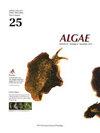Tropical red alga Compsopogon caeruleus: an indicator of thermally polluted waters of Europe in the context of temperature and oxygen requirements
IF 2.4
3区 生物学
Q1 MARINE & FRESHWATER BIOLOGY
引用次数: 0
Abstract
The red alga Compsopogon caeruleus can generally be found in tropical and subtropical waters worldwide. In addition to its natural habitats, this species may be found in waters that receive abnormally hot water, e.g., from powerhouses. To date, the presence of C. caeruleus has not been observed in thermally polluted lacustrine ecosystems in Poland, which has a moderate climate. The thalli of this red alga were found growing on Vallisneria spiralis in Licheńskie Lake. Importantly, this paper presents a previously unknown relationship between the temperature (20, 25, 30, 35, and 40°C) and oxygen requirements of C. caeruleus (based on ex situ measurements of O2 consumption by thalli). Surprisingly, 35°C can be the optimum temperature for C. caeruleus, and this temperature is higher than the values reported by some previous thermal analyses by approximately 10°C. Additionally, we reviewed and mapped the distribution of this nonnative and mesophilic red alga in natural / seminatural water ecosystems in Europe. Finally, we propose that the occurrence of C. caeruleus mature thalli can be a novel, simple and easy-to-recognize bioindicator of artificially and permanently heated waters in moderate climate zones by a regular discharge of postindustrial water.热带红藻盲藻:欧洲热污染水域温度和氧气需求的指标
红藻(Compsopogon caeruleus)普遍分布于全球热带和亚热带水域。除了它的自然栖息地,这个物种可能会在接受异常热水的水域中被发现,例如,从发电站。迄今为止,波兰气候温和,在热污染的湖泊生态系统中尚未观察到C. caeruleus的存在。这种红藻的菌体生长在Licheńskie湖的螺旋藻上。重要的是,本文提出了一个以前未知的温度(20、25、30、35和40°C)和C. caeruleus需氧量之间的关系(基于对菌体耗氧量的非原位测量)。令人惊讶的是,35°C可能是C. caeruleus的最佳温度,这个温度比以前一些热分析报告的值高出大约10°C。此外,我们回顾并绘制了这种非原生中温红藻在欧洲自然/半自然水生态系统中的分布。最后,我们提出,在中等气候地区,通过后工业水的定期排放,人工加热和永久加热的水中,成熟C. caeruleus成熟菌体的出现可能是一种新颖、简单和易于识别的生物指标。
本文章由计算机程序翻译,如有差异,请以英文原文为准。
求助全文
约1分钟内获得全文
求助全文
来源期刊

Algae
PLANT SCIENCES-
CiteScore
5.10
自引率
25.00%
发文量
18
期刊介绍:
ALGAE is published by the Korean Society of Phycology and provides prompt publication of original works on phycology. ALGAE publishes articles on all aspects of phylogenetics and taxonomy, ecology and population biology, physiology and biochemistry, cell and molecular biology, and biotechnology and applied phycology. Checklists or equivalent manu-scripts may be considered for publication only if they contribute original information on taxonomy (e.g., new combinations), ecology or biogeography of more than just local relevance. Contributions may take the form of Original Research Articles, Research Notes, Review Articles and Book Reviews.
 求助内容:
求助内容: 应助结果提醒方式:
应助结果提醒方式:


